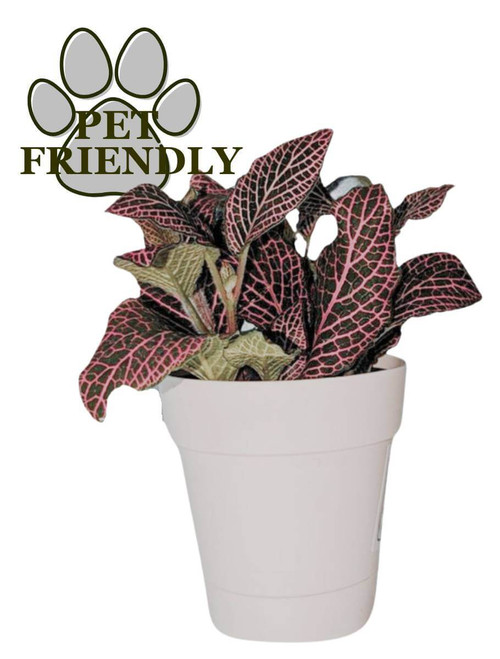NERVE PLANT RED
Fittonia, commonly known as the nerve plant, is a popular houseplant known for its striking foliage and relatively easy care. Normally cozying up as a trendy indoor buddy, the nerve plant (Fittonia) is a tiny evergreen with striking dark-green leaves sporting delicate veins. These leaves often flaunt silver-white veins but can also rock a sassy mix of red, pink, white, and green. These plants are native to the tropical rainforests of South America, particularly Peru. With their vibrant leaf patterns and unique appearance, Fittonia plants are a favorite among plant enthusiasts and interior decorators alike. Growing only 3 to 6 inches tall but spreading out like a leafy carpet up to 18 inches, Fittonia is your go-to buddy for slow and steady vibes, occasionally surprising you with dainty reddish or yellowish-white blooms indoors. In the right spot, it can even moonlight as a shady ground cover, adding a touch of green glam to your space.
PLANT CARE TIPS
Watering
It's common name comes from its dramatic habit of drooping visibly when it's thirsty. A lover of rainforest-like humidity, this little plant is great for terrariums and hanging baskets in the bathroom or near a humidifier. Keep soil constantly moist or nerve plant will dramatically droop it's leaves. Bit of a drama queen about it as it can look as though it's dead but once you add a bit of water it perks right up. You want to find a balance quickly though as constant wilting/drooping like that will take it's toll on a plant
Lighting
These guys can be finicky and fragile. It likes indirect but bright light which can be a tricky thing to find for it. A North or East facing window is your best bet. Some people opt to grow these under grow lights as you have alot more control over their light exposure and at least in the beginning a better % of success
Heat & Humidity
Again these guys can be fragile when it comes to its surrounding temperature but they thrive in high humidity. It does best at temperatures between 65 and 80 degrees, but should not be placed anywhere it could catch a breeze from a door or window opening regularly
Soil Medium
Plant Fittonia in a basic potting mix with a peat moss base that you can get at any hardware or nursery. For good measure we add about 20% more Perlite so we know the soil is going to drain fast enough to prevent root rot but also retain some moisture. It's a balance that you want to find to successful grow these guys
These guys can be pretty picky with their needs. One common problem people run into are the leaves wilting. Often this is a sign of underwatering or low humidity. Check soil moisture and increase humidity levels if possible. Leaf dropping can also be an issue and it's usually because the plant is in the wrong place and subject to drafts or sudden temperature changes. Brown leaf edges can occur from low humidity or over fertilization and yellow leaves can mean over watering.
Fittonia plants are not only decorative but also serve as natural air purifiers, helping to remove toxins from the air. Their vibrant colors can brighten up any room and add a touch of nature to indoor spaces. Fittonia nerve plants are a beautiful and unique addition to any houseplant collection. With proper care, they can thrive and bring a splash of color and life to your home. Whether you're a seasoned plant lover or a beginner, Fittonia plants are sure to captivate your interest with their stunning foliage and relatively low maintenance needs













